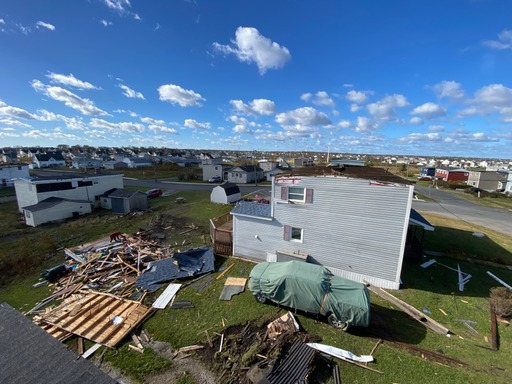While the Maritimes braces for the effects of hurricane Lee, which is forecast to arrive in the region Saturday, some people in Nova Scotia are still dealing with the aftermath of Fiona last year.

The damage to homes and infrastructure had long-lasting impacts that are still being addressed — and it’s all adding to the anxiety as severe weather events become more common.
For Sean Casey, it’s something that weighs heavily on his mind.
“We’ve had storms … we’ve had tropical storms, but this was different,” he said from his Glace Bay home on Cape Breton.
“It was terrifying.”

Fiona hit Nova Scotia as a post-tropical storm on Sept. 24, 2022. The storm caused significant damage and extensive flooding, and at one point, about 80 per cent of the province was without power.
The Insurance Bureau of Canada has since estimated the province saw more than $385 million in insured damages.

Cape Breton Island bore the brunt of Fiona, and the municipality would later declare a local state of emergency.

Get breaking National news
During the height of the event, Cape Breton Regional Municipality Mayor Amanda McDougall sent a message to Cape Bretoners to “stay strong” and would later describe the overnight storm as “surreal.”

Casey’s home, which has been in the family for more than seven decades, took a beating. A roof from a neighbouring house smashed into it, while his own roof was torn, which left water draining into the house.
“We had all gone downstairs, huddled in the living room. We brought some mattresses down and we thought, it’s another storm — could be a bad one — but we thought we’ll just huddle here and we’ll brave it,” he recalled.
“We had no idea how bad the damage was going to be.”
In the days, weeks and months after, recovery was not easy.
He’s thankful for the Mennonite community that helped in their time of need, securing their roof for winter before the job was ultimately finished just four months ago.
United Way Cape Breton endeavoured to co-ordinate the care for those in need.
“They are proud people who love to live here. Everybody loves to live in Cape Breton,” said Lynne McCarron, the agency’s executive director in Sydney, N.S.
“No different than anyone else, they want to be able to provide for their family, provide for their children, and we want to make sure that we help them do that.”
There were lessons learned too.
McDougall admits they now know to send requests for assistance directly to the federal government, because some details of the support they needed were lost.
She added that disaster financial assistance needs to be improved, because they’re still dealing with the effects of the 2016 storms.
“When you’re carrying debt loads from storms in 2016 because of bureaucracy, (that’s) unacceptable,” she said.
In addition to homes and livelihoods, infrastructure on the island has been forever changed.
Down toward Louisbourg, fallen trees tell the story. Meanwhile, the famed Lighthouse Trail is still shuttered because the risks are too great.
“Although parts of the trail weren’t damaged heavily, there were some really, literally, totally destroyed areas,” explained Eddie Kennedy with the Parks Canada Coastal Connections Trail Association.
Those who work to protect the island’s hiking trails say there has been a delay in getting government funding. Several studies to survey the damage and poor weather have also slowed down the process.
In total, the work is expected to cost about $200,000.
“There’s one particular spot where a brand new cove was made,” said Carter Stevens, the chair of the Coastal Connections Trail Association.
“We all would like to see it move as quick as possible, but in this particular case, we’re still moving forward and we hope to get it done by next year, for sure.”
All this work is happening in the midst of another active hurricane season.
Hurricane Lee, the 12th named storm of the season, is heading toward Nova Scotia and New Brunswick this weekend.
Having said that, back in Glace Bay, Casey said he would never consider leaving his home.
“If we won a lottery,” he joked.
“But even (then, I wouldn’t). This is our home. It’s been in the family forever.”
Leaving him and others on edge for future storms.









Comments